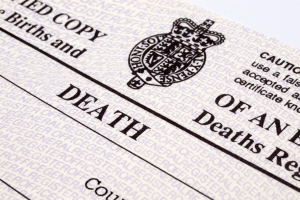Death certification changes: NHS England explanatory notes – 31 March

Coronavirus Act – excess death provisions: information and guidance for medical practitioners
1. Medical certificate of cause of death
Guidance on the medical certificate of cause of death (MCCD) is here.
a. Any medical practitioner with GMC registration can sign the MCCD, even if they did not attend the deceased during their last illness, if the following conditions are met:
i. The medical practitioner who attended is unable to sign the MCCD or it is impractical for them to do so and,
ii. the medical practitioner who proposes to sign the MCCD is able to state the cause of death to the best of their knowledge and belief, and
iii. a medical practitioner has attended the deceased (including visual/video consultation) within 28 days before death, or viewed the body in person after death (including for verification).
If another medical practitioner attended the deceased during their last illness or after death, the medical practitioner signing the MCCD should record the name and GMC number of the medical practitioner who attended the deceased during their last illness or after death at the ‘last seen alive’ section of the MCCD.
In addition to (i) to (iii) above, if no medical practitioner attended the deceased in the 28 days before death1 or after death, a medical practitioner can sign the MCCD if the following conditions are met:
iv. The medical practitioner who proposes to sign the MCCD is able to state the cause of death to the best of their knowledge and belief, and
v. the medical practitioner has obtained agreement from the coroner they can complete the MCCD.
Medical practitioners working in the same practice/hospital should find this straightforward as they can access patient records.
Reasons it is impractical for the attending medical practitioner to complete the MCCD might include: severe pressure on NHS services and the need to ensure medical practitioners with appropriate skills are available to treat patients; and/or medical practitioners becoming infected with COVID-19 and needing to self-isolate.
During periods of excess deaths due to Covid-19, healthcare providers are encouraged to redeploy medical practitioners whose role does not usually include direct patient care, such as some medical examiners, to provide indirect support by working as dedicated certifiers, completing MCCDs to enable other medical practitioners to focus on providing patient care.
b. Medical practitioners are required to certify causes of death “to the best of their knowledge and belief”. Without diagnostic proof, if appropriate and to avoid delay, medical practitioners can circle ‘2’ in the MCCD (“information from post-mortem may be available later”) or tick Box B on the reverse of the MCCD for ante-mortem investigations. For example, if before death the patient had symptoms typical of COVID-19 infection, but the test result has not been received, it would be satisfactory to give ‘Covid-19’ as the cause of death, tick Box B and then share the test result when it becomes available.
c. The period during which an attending medical practitioner completing an MCCD must have seen the deceased before death (the ‘last seen alive’ requirement) is extended from 14 days to 28 days before death. ‘Seen’ in this context includes consultation using video technology. However, it does not include consultation by telephone/audio only.
d. The MCCD can be scanned or photographed and sent from a secure email account to registrars as an attachment. We recommend electronic transfer of MCCDs is used as standard practice. We expect registrars to determine the appropriate email address – for example, a secure email account.
e. Covid-19 is an acceptable direct or underlying cause of death for the purposes of completing the MCCD.*
Source: NHS England, Coronavirus Act – excess death provisions: information and guidance for medical practitioners [published 31 March]
Pulse July survey
Take our July 2025 survey to potentially win £1.000 worth of tokens











